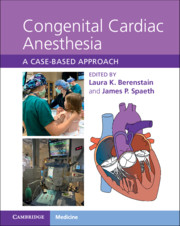Book contents
- Congenital Cardiac Anesthesia
- Congenital Cardiac Anesthesia
- Copyright page
- Dedication
- Contents
- Contributors
- Introduction
- Chapter 1 A Congenital Heart Disease Primer
- Section 1 Left-to-Right Shunts
- Section 2 Right-Sided Obstructive Lesions
- Chapter 6 Critical Pulmonic Stenosis
- Chapter 7 Tetralogy of Fallot
- Chapter 8 Repaired Tetralogy of Fallot
- Chapter 9 Tetralogy of Fallot with Absent Pulmonary Valve Syndrome
- Chapter 10 Tetralogy of Fallot, Pulmonary Atresia, and Aortopulmonary Collaterals
- Chapter 11 Pentalogy of Cantrell
- Chapter 12 Ebstein Anomaly
- Chapter 13 Ebstein Anomaly, Palliated
- Section 3 Left-Sided Obstructive Lesions
- Section 4 Complex Mixing Lesions
- Section 5 Single-Ventricle Physiology
- Section 6 Heart Failure, Mechanical Circulatory Support, and Transplantation
- Section 7 Miscellaneous Lesions and Syndromes
- Index
- References
Chapter 11 - Pentalogy of Cantrell
from Section 2 - Right-Sided Obstructive Lesions
Published online by Cambridge University Press: 09 September 2021
- Congenital Cardiac Anesthesia
- Congenital Cardiac Anesthesia
- Copyright page
- Dedication
- Contents
- Contributors
- Introduction
- Chapter 1 A Congenital Heart Disease Primer
- Section 1 Left-to-Right Shunts
- Section 2 Right-Sided Obstructive Lesions
- Chapter 6 Critical Pulmonic Stenosis
- Chapter 7 Tetralogy of Fallot
- Chapter 8 Repaired Tetralogy of Fallot
- Chapter 9 Tetralogy of Fallot with Absent Pulmonary Valve Syndrome
- Chapter 10 Tetralogy of Fallot, Pulmonary Atresia, and Aortopulmonary Collaterals
- Chapter 11 Pentalogy of Cantrell
- Chapter 12 Ebstein Anomaly
- Chapter 13 Ebstein Anomaly, Palliated
- Section 3 Left-Sided Obstructive Lesions
- Section 4 Complex Mixing Lesions
- Section 5 Single-Ventricle Physiology
- Section 6 Heart Failure, Mechanical Circulatory Support, and Transplantation
- Section 7 Miscellaneous Lesions and Syndromes
- Index
- References
Summary
Pentalogy of Cantrell is a syndrome consisting of (1) a midline, supraumbilical abdominal wall defect; (2) a congenital heart defect; (3) a lower sternal defect; (4) an anterior diaphragmatic defect; and (5) a diaphragmatic pericardial defect. Patients present a challenge to both the surgeon and anesthesiologist in the operating room due to the wide spectrum of anomalies with various complexities they bring. Planning dictates a multidisciplinary approach involving neonatology, cardiology, cardiac surgery, general surgery, anesthesiology, and pertinent subspecialties to determine the best course of action. Generally, corrective strategies include separation of the peritoneal and pericardial cavities with coverage of midline defects, omphalocele correction, repair of intracardiac lesions, and restoration of the heart into the thoracic cavity, all while preserving/establishing musculoskeletal structural integrity and hemodynamic stability. The potential for significant cardiopulmonary compromise is high and must be understood and anticipated when caring for these patients.
Keywords
- Type
- Chapter
- Information
- Congenital Cardiac AnesthesiaA Case-based Approach, pp. 64 - 69Publisher: Cambridge University PressPrint publication year: 2021

